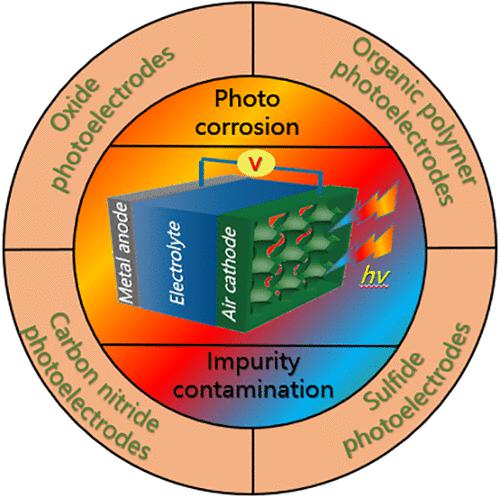当前位置:
X-MOL 学术
›
Energy Fuels
›
论文详情
Our official English website, www.x-mol.net, welcomes your
feedback! (Note: you will need to create a separate account there.)
Air Cathode Design for Light-Assisted Charging of Metal–Air Batteries: Recent Advances and Perspectives
Energy & Fuels ( IF 5.2 ) Pub Date : 2023-06-20 , DOI: 10.1021/acs.energyfuels.3c01107 Fayun Wu 1 , Cuie Wang 2 , Kaiming Liao 1 , Zongping Shao 1
Energy & Fuels ( IF 5.2 ) Pub Date : 2023-06-20 , DOI: 10.1021/acs.energyfuels.3c01107 Fayun Wu 1 , Cuie Wang 2 , Kaiming Liao 1 , Zongping Shao 1
Affiliation

|
Metal–air batteries are a type of electrochemical cell that generates electrical energy by combining metal and oxygen from the air. They are a promising technology for energy storage and portable devices because of their high energy density, low cost, and environmental friendliness. However, the discharge products of these batteries are notoriously difficult to decompose, resulting in a high overpotential. Recent works have shown that semiconductors can capture solar energy and store it in batteries. When exposed to light, photocatalysts generate carriers (strong redox pairs), thereby increasing the electron migration rate and significantly reducing the overpotential of the metal–air battery reaction. Nevertheless, single photocatalysts often exhibit poor cycle performance due to serious carrier recombination. This review paper begins by briefly describing the fundamentals of photoelectrochemistry and then focuses on commonly used photocathode design principles and various reported photocatalysts. It also discusses the main challenges and issues caused by light, such as photocorrosion and electrolyte decomposition. Finally, the critical issues associated with photo electrodes, electrolytes, and electrode/electrolyte interfaces are emphasized, and perspectives on the development of high-performance light-assisted metal–air batteries are presented.
中文翻译:

用于金属空气电池光辅助充电的空气阴极设计:最新进展和前景
金属空气电池是一种电化学电池,通过结合金属和空气中的氧气来产生电能。由于其能量密度高、成本低且环境友好,它们是一种很有前景的能量存储和便携式设备技术。然而,这些电池的放电产物非常难以分解,导致过电位很高。最近的研究表明,半导体可以捕获太阳能并将其存储在电池中。当暴露在光线下时,光催化剂会产生载流子(强氧化还原对),从而提高电子迁移速率并显着降低金属-空气电池反应的过电位。然而,由于严重的载流子复合,单一光催化剂往往表现出较差的循环性能。本文首先简要描述光电化学的基础知识,然后重点介绍常用的光电阴极设计原理和各种报道的光催化剂。它还讨论了光引起的主要挑战和问题,例如光腐蚀和电解质分解。最后,强调了与光电极、电解质和电极/电解质界面相关的关键问题,并提出了高性能光辅助金属空气电池的发展前景。
更新日期:2023-06-20
中文翻译:

用于金属空气电池光辅助充电的空气阴极设计:最新进展和前景
金属空气电池是一种电化学电池,通过结合金属和空气中的氧气来产生电能。由于其能量密度高、成本低且环境友好,它们是一种很有前景的能量存储和便携式设备技术。然而,这些电池的放电产物非常难以分解,导致过电位很高。最近的研究表明,半导体可以捕获太阳能并将其存储在电池中。当暴露在光线下时,光催化剂会产生载流子(强氧化还原对),从而提高电子迁移速率并显着降低金属-空气电池反应的过电位。然而,由于严重的载流子复合,单一光催化剂往往表现出较差的循环性能。本文首先简要描述光电化学的基础知识,然后重点介绍常用的光电阴极设计原理和各种报道的光催化剂。它还讨论了光引起的主要挑战和问题,例如光腐蚀和电解质分解。最后,强调了与光电极、电解质和电极/电解质界面相关的关键问题,并提出了高性能光辅助金属空气电池的发展前景。


















































 京公网安备 11010802027423号
京公网安备 11010802027423号